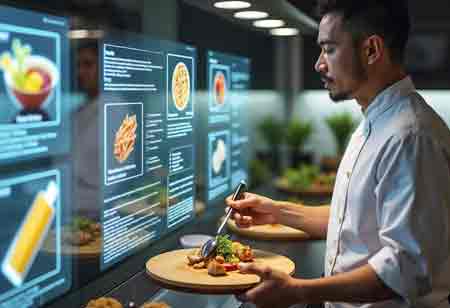THANK YOU FOR SUBSCRIBING
Be first to read the latest tech news, Industry Leader's Insights, and CIO interviews of medium and large enterprises exclusively from Food and Beverage Tech Review
Ensuring Safety and Transparency: The Power of IoT in the Food Industry
Food processors can use IoT devices to handle various operational and quality-control tasks. This involves processing different meals in large quantities, keeping processed goods at a certain temperature, adjusting the pressure in cans, and even labeling goods.

By
Food and Beverages Tech Review | Friday, November 07, 2025
Stay ahead of the industry with exclusive feature stories on the top companies, expert insights and the latest news delivered straight to your inbox. Subscribe today.
Fremont, CA: IoT-based applications are significantly improving food safety in food processing establishments. They provide one opportunity to monitor a supply chain, use sensors to check food quality, and alert users to potential safety risks, thereby improving the process of food processing and manufacturing.
Real-Time Temperature Data
IoT systems employ a wide range of sensors, including real-time temperature, moisture, carbon dioxide, and heavy metal sensors, to monitor food quality in fields and during transportation and to alert users to potential contamination risks.
It is easier to identify any contaminated items or incorrect environmental conditions, whether handled on-site or throughout other operations. Then, before they damage further food or endanger consumers, they may be appropriately held or removed from a processing line.
IoT Sensors
During shipping, goods and packaging can frequently sustain damage that results in stock loss, lost time and money, and business interruption. It might be not easy to prevent downtime for food businesses that get their packaging from outside sources.
Nonetheless, IoT sensors might be useful since they can automatically identify damage and deterioration in packaging. This helps producers reduce the possibility that this will happen again, saves time, and guarantees the quality of packing.
Traceability and Food Safety
The origins of their food are a growing issue for consumers. The epidemic reaffirmed their demands for openness and traceability about the origins of their food. IoT technology, which enables consumers to follow items along the whole supply chain, can help satisfy these needs and foster customer trust. Customers will be provided with the transparency and assurance they require by being able to access information about ingredients, supply, raw materials, and finished food items.
Ensuring food safety is another benefit of IoT technology. Real-time food safety data is available to food makers, enabling them to closely monitor conditions and satisfy HACCP and food safety regulations. Additionally, IoT technology may alert employees to potential food safety violations, allowing them to promptly determine whether or not contamination has occurred.
Food Waste Reduction
A significant proportion of food is wasted during food manufacture, handling, and storage. IoTs, however, can assist in reducing this. Based on real demands, orders can be issued for new ingredients. Because of this, workers cannot estimate how much food is needed, which can result in wasteful food loss. IoT technology can even automate this process to increase productivity and decrease waste.
In addition, real-time sensor data collection on food production can assist in determining and mitigating the underlying causes of food waste. You can quickly decide which goods are overstocked and which aren't by using essential data that the IoT can offer, such as expiration dates and stock levels. This tackles the issue of food waste and stops people from placing unnecessary orders.
I agree We use cookies on this website to enhance your user experience. By clicking any link on this page you are giving your consent for us to set cookies. More info







